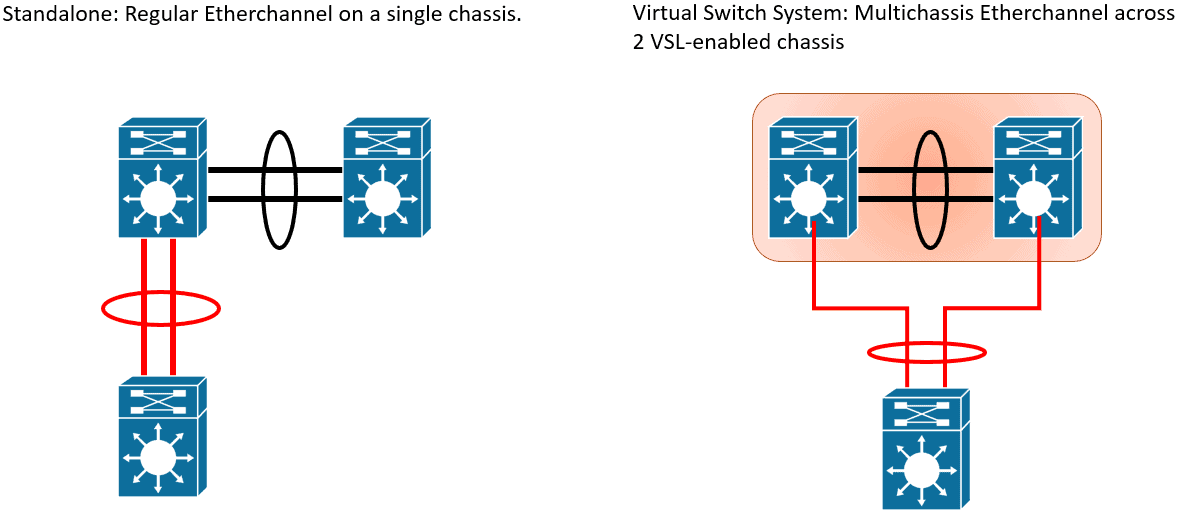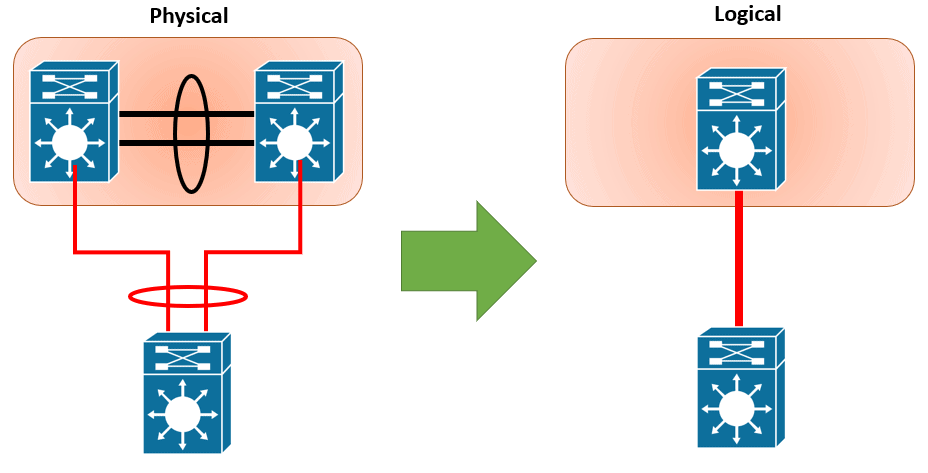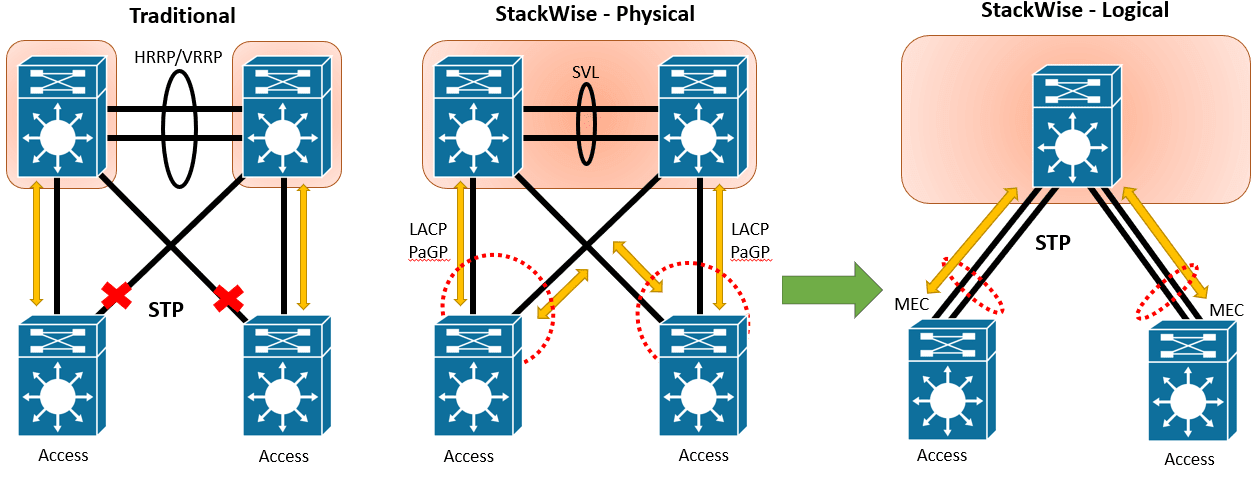Multichassis Etherchannel (MEC) is the implementation name used in Cisco switch families with Virtual Switching System (VSS) capability, StackWise, and vPC are options that are deployed in enterprises and data centers across the world. Multichassis Etherchannel is a Layer 2 multi-path technology that allows connected nodes to terminate the Etherchannel across the two physical Cisco switches.
Virtual Switching System (VSS)
Before Cisco VSS, Etherchannels were not allowed to be within the same physical switch. Unlike in a Virtual Switching environment, the two physical switches can establish a single logical network entity enabling Etherchannels to be extended across two physical chassis, hence the term Multichassis Etherchannel (MEC).
MEC links on both the switches are managed by PAgP or LACP running on the ACTIVE switch via internal control messages. MEC enables the VSS technology and appears as a single switch or a single logical device to devices with connectivity to the VSS. Therefore, Virtual Switching System supports the implementation of link aggregation where the physical links will be seen as a single logical link.
Traditionally, spanning VLANs over multiple closets would create Spanning Tree Protocol looped topology. MEC in VSS topology results in the elimination of these loops in the campus topology. Below is an example illustration of VSS topology in physical and logical.
StackWise Virtual
StackWise allows link aggregation of two physical switches together into a single logical switch. The two switches share the same configuration and forwarding state. This Etherchannel technology allows for enhancements in all areas of network design, including high availability, scalability, management, and maintenance.
This virtualization of the two different switches into a single logical switch fundamentally alters the design of the topology. The most noteworthy change is that StackWise Virtual prevents loops in the topology because the two physical switches operate as one. Thus, the spanning-tree domain treats the StackWise Virtual pair as one bridge node instead of two. In addition, StackWise Virtual also incorporates many other Cisco innovations—such as Stateful Switch Over (SSO), Non-Stop Forwarding (NSF), and Multi-chassis EtherChannel (MEC)—that enable non-stop communication with increased bandwidth to substantially enhance application response time.
Here are the major benefits of implementing StackWise in the business:
- Reduced looped topology-related risks.
- Reliable business communication through the use of a redundant chassis with SSO-enabled supervisors.
- Higher existing investment returns through increased bandwidth from the access layer.
- Reduced misconfigurations and elimination of First Hop Redundancy Protocols (FHRP), such as Hot Standby Routing Protocol (HSRP), GLBP, and VRRP.
- Simplified management due to a single configuration, thus having fewer operational failure points.
Virtual Port Channel (vPC)
Virtual Port Channel is a feature that provides the ability to configure a port channel across multiple switches. VSS is different from vPC because VSS creates a single logical switch resulting in a single control plane for management and configuration purposes. Wherein with vPC, each switch is managed and configured independently. Always bear in mind that since each switch is managed independently, therefore VLAN creation should be done on both Nexus switches.
vPC enhances the following hardware and software redundancy features:
- vPC uses all port-channel member links available. Therefore, if an individual link fails, all of the traffic will be redirected to the remaining working links.
- The vPC domain has two peer devices and each peer device processes half of the traffic from the access layer. If one of the peer devices fails, the other running peer device will absorb all of the traffic with a minimum convergence time impact.
- The peer devices in the vPC domain run their own control plane. Both of the peer devices work independently, and any potential control plane issues stay local to the peer device. If one of the peer devices has an issue, it will not proliferate and affect the other peer device.
- vPC eliminates Spanning Tree Protocol (STP) blocked ports and uses all available uplink bandwidth. Spanning-Tree is used as a fail-safe mechanism and does not dictate the Layer 2 path for vPC-attached devices.
Within a vPC domain, users can connect to the access devices via the following:
- vPC-attached connections leveraging Active/Active connectivity with port-channel
- Active/Standby connectivity using STP
- Single attachment without STP running on the access device
Download our Free CCNA Study Guide PDF for complete notes on all the CCNA 200-301 exam topics in one book.
We recommend the Cisco CCNA Gold Bootcamp as your main CCNA training course. It’s the highest rated Cisco course online with an average rating of 4.8 from over 30,000 public reviews and is the gold standard in CCNA training:



